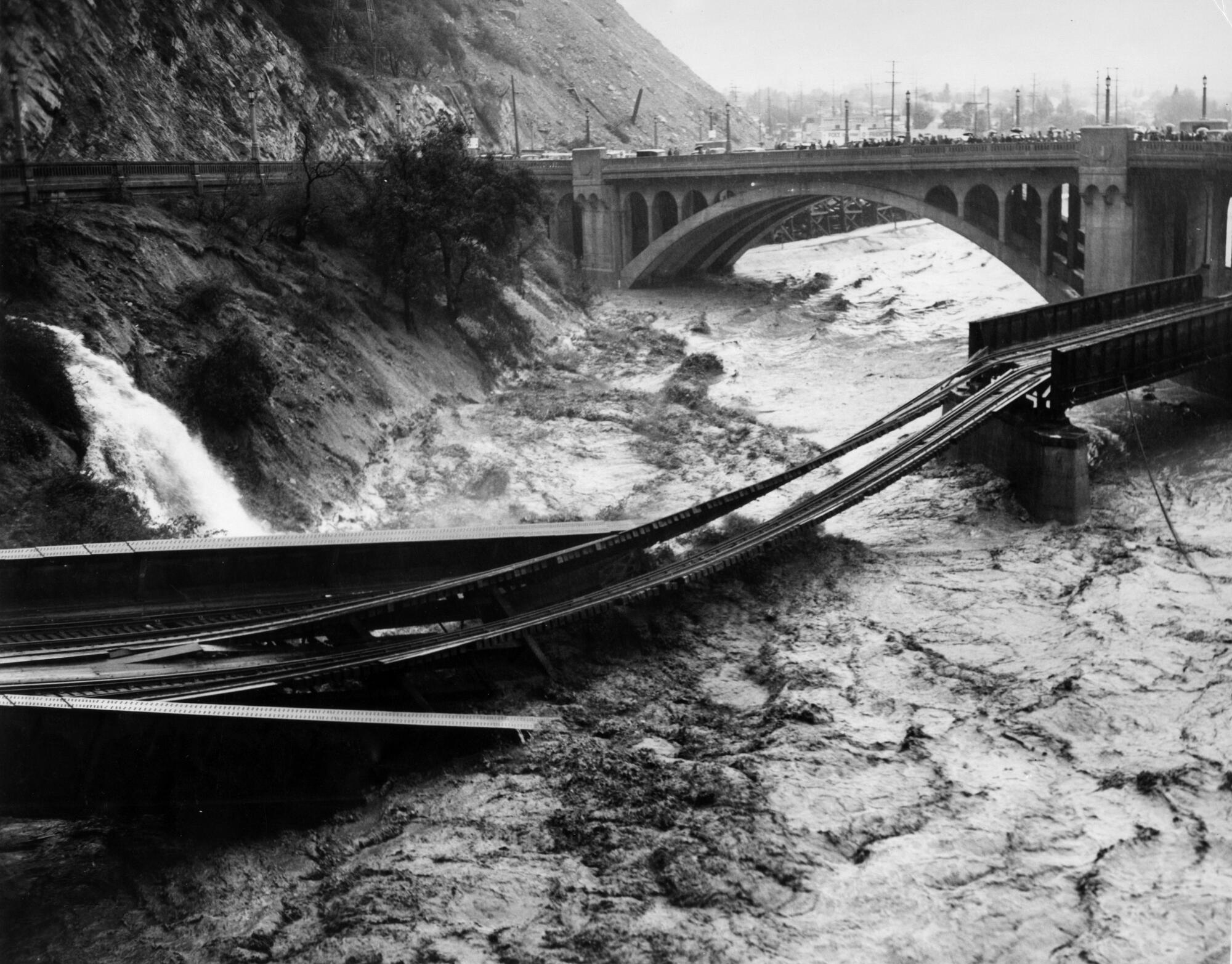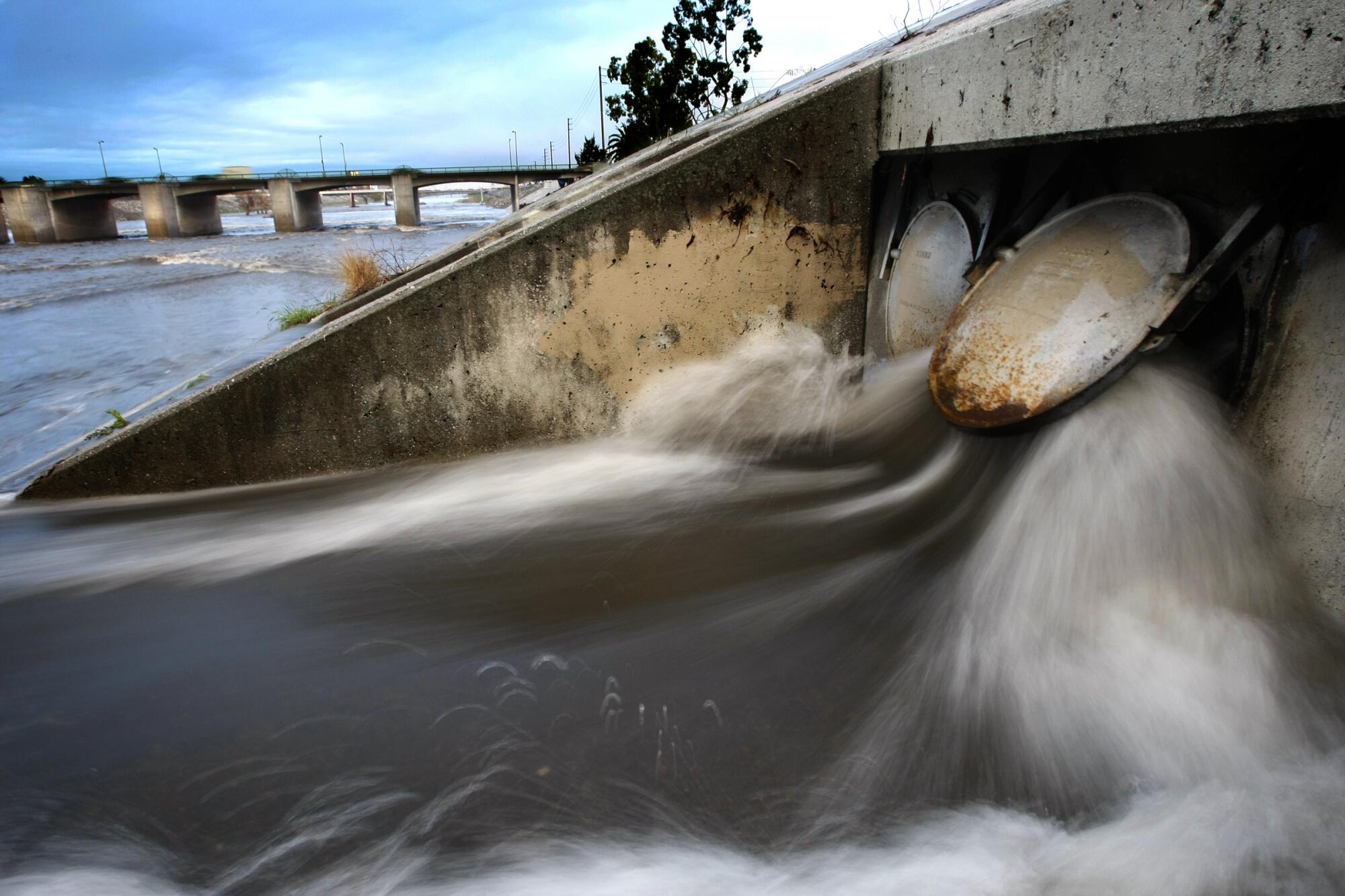As intense atmospheric rivers grow to be extra widespread in a warming world, so too do questions on stormwater seize in Los Angeles. Annually, when rain pours down and the L.A. River roars again to life, Angelenos wish to know the way a lot of that water is being captured and saved — and the way a lot is washing out to sea.
The monster storm that hammered Southern California this week dropped billions of gallons of rain, however as a lot as 80% of that water was whisked into the Pacific Ocean, consultants say.
For residents who solely just lately have been requested to preserve unprecedented quantities of water, such a loss may be confounding. However capturing rainfall is just one a part of the L.A. River’s job. Additionally it is a flood management channel that’s important to defending lives and properties when stormwaters surge.
“It’s a fragile steadiness between capturing that water for useful use afterward and maintaining the general public protected — ensuring that folks can get to work and that kids can get to high school,” mentioned Kerjon Lee, a spokesman for the Los Angeles County Division of Public Works.
Certainly, with out the Los Angeles River and different native channels akin to Ballona Creek, extra of that stormwater would have ended up in streets and neighborhoods. The waterways have been channelized practically 100 years in the past in response to devastating regional flooding.
“We developed a lot of L.A. too shortly and too near the floodplain, and so we had huge floods — not simply within the L.A. River however the San Gabriel and others — within the ’30s, and even some earlier than the ’30s,” mentioned Bruce Reznik, govt director of Los Angeles Waterkeeper.

March 2, 1938: Remnants of a destroyed Southern Pacific Railroad bridge are submerged within the roiling waters of the Los Angeles River, in a photograph taken from North Figueroa Road.
(Los Angeles Occasions)
As soon as a free-flowing waterway, the L.A. River flooded repeatedly as town was developed. A 1914 flood triggered an estimated $10 million value of injury; the L.A. Occasions reported that town was “within the grasp of swirling water.”
On New 12 months’s Day in 1934, a storm as soon as once more unleashed torrents from the San Gabriel Mountains. The river and its tributaries swelled, inundating communities round La Crescenta and claiming dozens of lives and homes.
And in 1938, an important deluge modified town and its river perpetually. Engorged by two back-to-back storms, the waterway roared as flows reached the exceptional price of 99,000 cubic ft per second. Water quickly poured into low-lying areas from downtown to Lengthy Seaside, sweeping away greater than 5,600 constructions and killing greater than 110 folks.
In response to the $78-million disaster, the folks of Los Angeles known as for larger flood management measures, and the U.S. Military Corps of Engineers started encasing the channel in concrete. Consultants credited the work with stopping floods in 1969 and 1980, when the river noticed even increased flows than it had in 1938.
In that regard, Reznik mentioned, the system “is working as supposed.”
However that doesn’t imply there’s no room for enchancment. The Division of Public Works has captured about 11,200 acre-feet, or 3.6 billion gallons, of water from the newest storm — sufficient to be used by about 89,600 folks for a yr. The company has captured about 72,500 acre-feet because the begin of the water yr, Oct. 1.

March 2, 1938: Drains couldn’t sustain with rain filling streets in downtown Los Angeles.
(Los Angeles Occasions)
Most of that comes by groundwater recharge, or alternatives for water to unfold and seep into aquifers. Public Works additionally maintains 14 main dams within the mountains above L.A., in addition to 5 others operated at the side of the Military Corps. In the course of the summer season, water is launched from these dams into spreading grounds for percolation.
The maneuvers are a dance “between flood safety and stormwater seize,” in line with Lee. “We would like as a lot capability as attainable in these dams to seize the water and attempt to maintain it up there within the dams for so long as we will, with out threatening lives and property downstream.”
However Reznik and different consultants mentioned Los Angeles can and ought to be extra formidable.

The Los Angeles River close to downtown.
(Mark Boster / Los Angeles Occasions)
In 2018, voters authorised Measure W, a tax geared toward capturing and cleansing extra stormwater earlier than it reaches the ocean. That initiative, later dubbed the Protected Clear Water Program, allocates $280 million yearly to stormwater tasks, together with these geared towards decreasing asphalt and hardscaping that stop water from seeping into the earth.
A report on this system final yr discovered that its progress has been sluggish, with about 30 acres of inexperienced area added throughout the 3-million-acre county within the first three years.
“Having 90% of runoff heading down the L.A. River isn’t good from a water provide — isn’t good from a air pollution, isn’t good from a public security — standpoint,” Reznik mentioned. “And so I believe that’s the place we’re going to essentially should ask some laborious questions on how we will do a greater job.”
Los Angeles imports the overwhelming majority of its water from different locations, together with Northern California, the Owens Valley and the Colorado River. However as drought and warming make these sources much less dependable, the necessity for native provides has by no means been extra important, Reznik mentioned.
What’s extra, the growing probability of utmost storms — akin to this week’s atmospheric river or Hurricane Hilary in 2023 — underscores the urgency of the work. The newest storm was the third “thousand-year” occasion — one with a 0.1% probability of occurring in any given yr — to hit Southern California this winter.

Stormwater surges from an outfall pipe into the Los Angeles River in Lengthy Seaside.
(Don Bartletti / Los Angeles Occasions)
That’s an issue, as a result of most of California’s water techniques have been constructed for “hundred-year” storms, or rain occasions with a 1% probability of occurring, mentioned Anne Lynch, a civil engineer and water administration skilled with GHD, a consulting agency.
“We’re residing off of our grandparents’ investments in our water infrastructure,” she mentioned. “It’s time for us now. We’re all going to should pay for the long run, to deal with local weather change and the degradation of our current techniques as they attain the top of their helpful life.”
The excellent news is that L.A. has the funds to make good investments in stormwater seize, she mentioned.
Measure W contains quite a lot of efforts to “discover methods to incentivize folks to place permeable pavers of their driveways and simply do completely different tasks all around the L.A. Basin,” Lynch mentioned. “We’re form of taking it in small snippets, however all of that manages to seize circulate, recharge it to the groundwater and in addition helps with seawater intrusion and an entire host of different issues.”
Measure W has seen some success, such because the East Los Angeles Sustainable Median Stormwater Seize Challenge, which helps to infiltrate roughly 7.1 million gallons of runoff within the Rio Hondo watershed close to Montebello. The mission additionally offers above-ground enhancements, akin to jogging paths, timber and drought-tolerant landscaping.
County officers mentioned it might take three to 5 many years for Measure W to succeed in its objective of capturing 300,000 acre-feet, about 98 billion gallons, of water yearly. However throughout final yr’s remarkably moist winter, the county exceeded expectations and captured 628,508 acre-feet, in line with Public Works.
“Not yearly goes to be final yr, however capturing sufficient water for half the inhabitants for a yr exhibits what is doubtlessly doable,” Reznik mentioned.

The Los Angeles River flows quick and muddy in February 2023.
(Brian van der Brug / Los Angeles Occasions)
There are different regional tasks underway, together with new spreading floor services from the Los Angeles Division of Water and Energy, “which is able to all be contributing to the groundwater regionally and future drinking-water provide in Los Angeles,” Martin Adams, the final supervisor, mentioned throughout a information convention this week.
The Metropolitan Water District of Southern California, a large regional wholesaler, has additionally been monitoring flows from the storm, in line with spokeswoman Rebecca Kimitch. Though the MWD doesn’t instantly handle or retailer native runoff, its 26 member companies usually seize about 1.1 million acre-feet of stormwater every year, she mentioned. About 500,000 acre-feet are despatched to the ocean.
“On common, about half of that circulate to the ocean occurs over three days of the yr, throughout giant storm occasions like this,” Kimitch mentioned. “Throughout such storms, the flows are so quick, it may be tough to seize, and the precedence is flood management.”
The newest atmospheric river parked itself over Southern California on Sunday and delivered 60% of L.A.’s common seasonal rainfall in simply three days, in line with the Nationwide Climate Service. Downtown L.A. obtained a complete of 8.51 inches Sunday, Monday and Tuesday — its second-wettest three-day run since official information started in 1877. The very best three-day whole was 9.21 inches, in the course of the 1938 flood.
This week’s storm left a path of chaos, together with freeway closures, submerged automobiles, landslides and evacuations. The L.A. River raged; movies present swirling brown water roaring by the channel. On Monday afternoon, the Los Angeles Hearth Division rescued an individual who was swept away within the river’s fast waters.
“The banks of the river aren’t — and I repeat — aren’t the place to be in the course of the storm,” Chief Kristin Crowley mentioned throughout a information convention Tuesday. “The L.A. River is full and can proceed to circulate with excessive depth right this moment.”
But the river has largely held — absorbing the near-record precipitation from the storm, due to in depth preparations, drain clearing and dredging of particles, officers mentioned. Nonetheless, some expressed concern that it may be pushed solely thus far.
“The system can deal with a number of atmospheric rivers, so long as they’ve some spacing between them,” Dena O’Dell, a spokeswoman for the U.S. Military Corps of Engineers, advised The Occasions. “When they’re back-to-back and not using a break, the system may very well be examined.”
Whereas the county is investing in stormwater seize, such investments are in a race in opposition to upstream growth that’s creating extra impermeable areas and growing flows — not in contrast to the circumstances that led to the floods within the final century.
Lynch, of GHD, mentioned creating extra permeability and stormwater seize capabilities might assist preserve historical past from repeating itself, as it’ll improve the system’s flexibility by creating extra locations to place water.

The Los Angeles River, close to Atwater Village, on Monday.
(Ringo Chiu / For The Occasions)
“It’s a very good signal that we’re not doing issues only for one profit anymore,” she mentioned.
For now, nevertheless, there are billions — if not tens of billions — of gallons of runoff that aren’t recharging aquifers and are persevering with to pollute waterways and pose well being and security threats, Reznik mentioned.
If L.A. can proceed to cut back storm flows by creating extra inexperienced area, “it type of turns into a win for everyone,” he mentioned.
In different phrases, capturing extra stormwater from the L.A. River would have the twin advantage of maintaining extra folks protected and saving them extra water.


